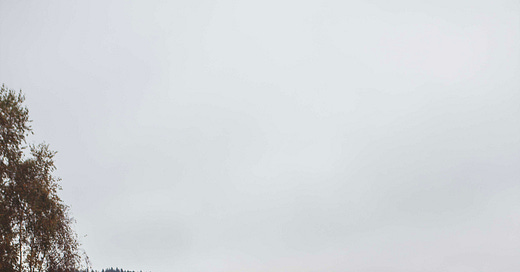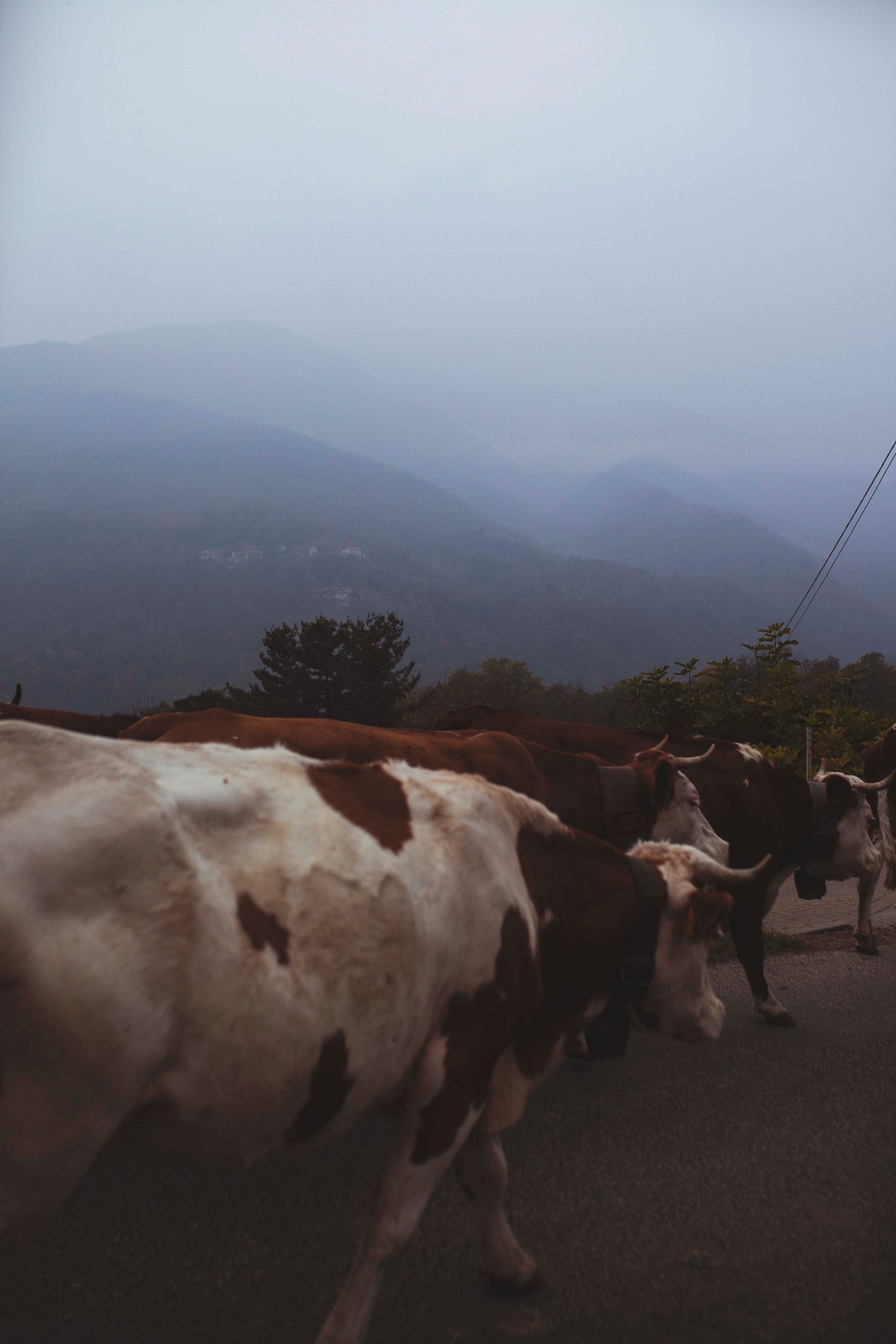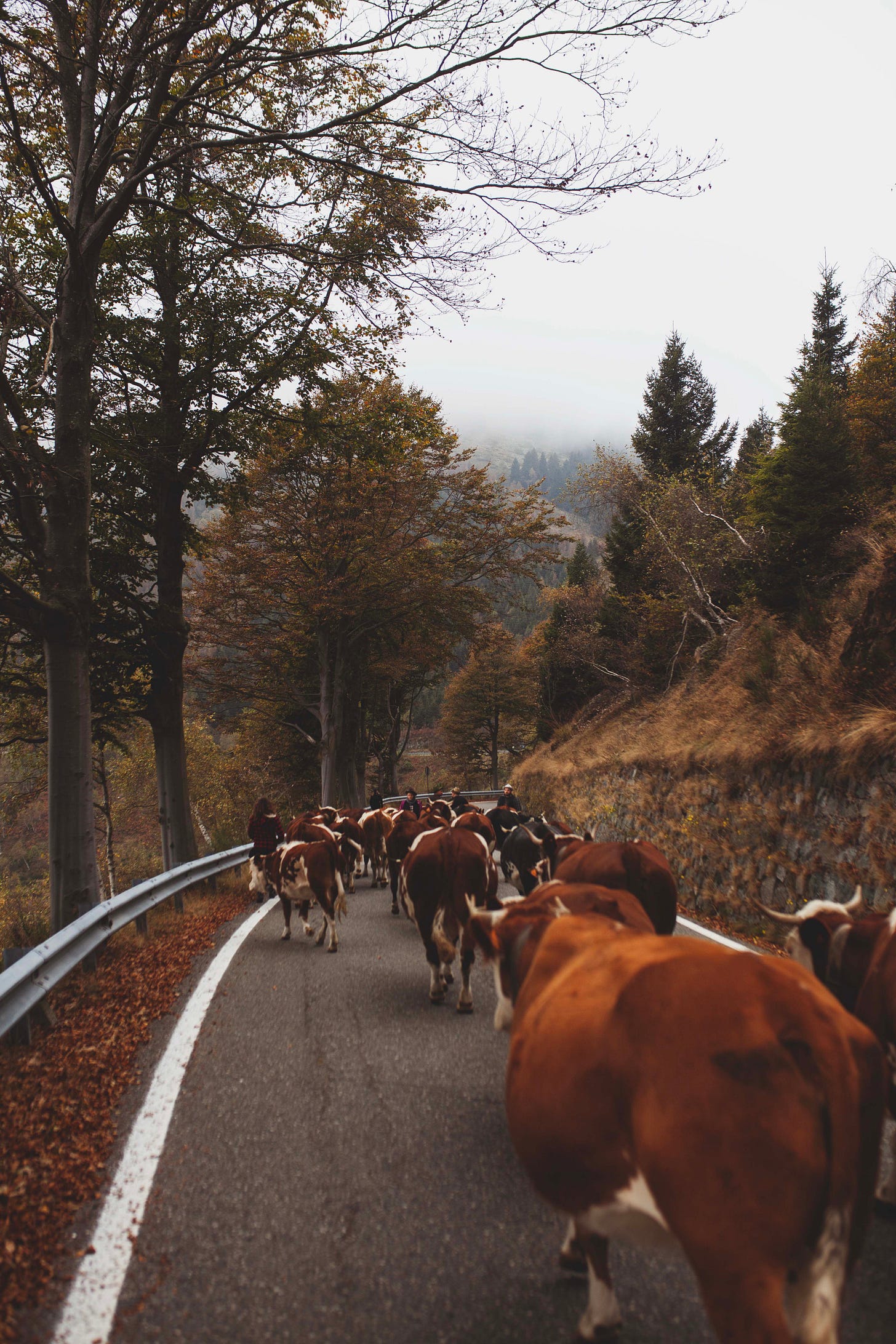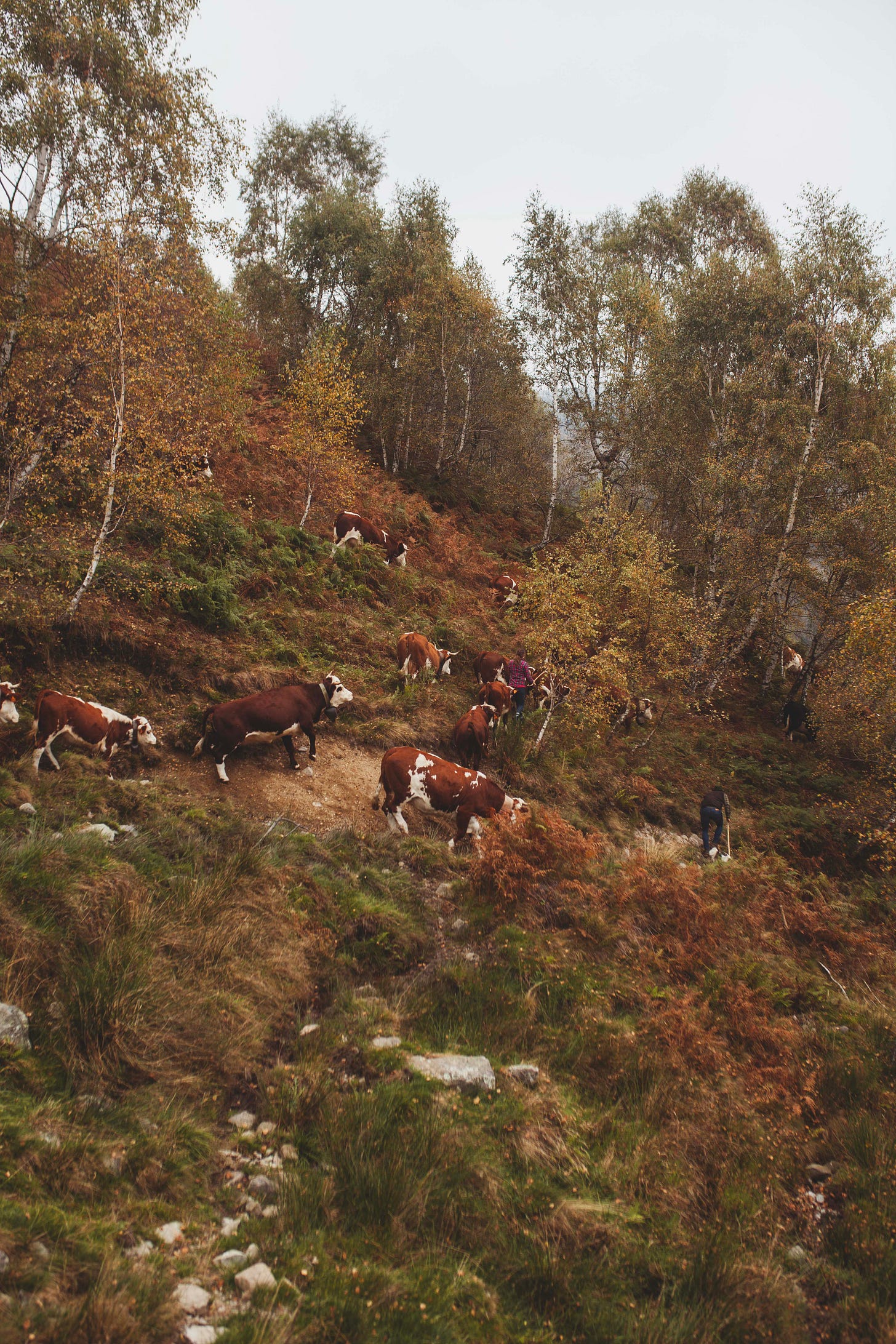THE DESALPA TRANSHUMANCE // Biella // Piemonte // ITALY // PART ONE
A two-part description of the autumn desalpa transhumance in Piedmont, where we drive the herd of thirty-ish cows 25km off a mountain and down through the city of Biella at night.
I’m just back from a recent trip the pre-alps in northern Italy, joining my friends in the yearly descent of the herd they have been living with through the summer making Macagn’, one of the rare cheeses I champion that is close to my heart. The desalpa is the first transhumance I joined back in 2017 and is absolutely huge in its impact in terms of connection to the landscape through food. It is at the very core of Up There The Last.
This piece is in two parts. I like the slightly delirious feel it has, written so soon after the transhumance.
Paid subscribers get 20+ photographs from the trip which I am extremely pleased with, and also first access to the podcast I made, so you can hear the bells!
LA DESALPA 2023 : PART ONE
Max Jones
It’s in the name. At the beginning of summer there is the alpá. A beautiful moment in mountain regions whose communities are inextricably linked with the seasonal movement of livestock into upland pasture, upon whom both herd and herder are dependent to survive their given geographical context.
In May, looking up from the valley below, swathes of green reveal themselves with the spring melting of snow. This abundant alpine pasture is converted into milk by the herd and worked by the herder during the summer, transforming and stabilising the mountain into butter and cheese, providing food that lasts long into the depths of winter using methods that are heartily set into this way of sustaining life that is very old indeed. It is a positive time, where the bells of the cows heading up signal to everyone within earshot on their twenty-five kilometre ascent the arrival of summer, and farewell to winter woes. Flowers, fanfares, sweet, lactic scents mingling with the smoke of the chalet’s fire cooking curds in the copper pot and outside, the alpine meadows’ floral fragrance signals a season of bounty ahead.
The intention is there in the way you say it-
“al-pAH!”.
Even the acute accent on the second “á” suggests upwards and adventure to me.
The desalpa is different altogether.
I’m just travelling back to Ireland from this year’s desarpa, disalpá, dévétéya or desalpa in Piedmont. That is how my herder friends call it, and my shin muscles are killing me.
As summer ends, the cows need moving off the mountain as soon as the temperature drops and the weather worsens. They need to stay on the mountain for as long as possible, benefitting from the pasture, so there is no set date for when they come back down to the safety of the valley bellow. I was once even told about a cheesemaker in the Savoie who’s neighbour stayed too long, into November, and perished in the blizzards with her small herd.
It is always a last minute event, nobody is really aware of when it might happen other than Adam Ferrero, who’s herd it is that needs moving. It is a twelve hour trek into the night and there is a good chance it might rain.
For this, I keep the latter half of October free in case I receive the call to help, usually with less than a week’s notice. I anticipate when this might be by keeping an eye on the weather around Biella in Northern Italy.
It is a Tuesday, I walk ten minutes down the road from my family home and make a right into a driveway marked by a convex orange road mirror. The herders are to meet at this farm around midday, at the foot of the mountain in Camburzano, all terracotta roofed houses clustering up from the flat-lands, with peach-pink church spires poking out against the deep greens of the looming mountains to the north. This is where the cows will spend the winter and is our destination for later that night.
We sit around drinking coffee sweetened with chestnut honey and doctored with grappa, waiting on friends and family of Adam’s. Once everyone has arrived, we pile into his pick-up truck that tows an orange horse-box and drive the beautiful auburn bends of the autumnal Cervo valley, which takes around an hour, to their small family restaurant just above the treeline on Bielmonte. We find the grazing herd by following the sound of their mountain bells, where the herders swap the smaller ones they have been wearing all season with much larger, louder things, whose dull leather straps are adorned with hand-hammered rivets in the shape of mountain flowers, some easily a hundred years old.
We leave them to feed and head in for a feed ourselves, one of the most important phases of the desalpa. The restaurant is a timber chalet, perhaps built in the 1970s, with posters of Terence Hill and Bud Spencer on the walls with a large fireplace at the centre of the room. My good friend Giada, Adam’s sister runs the place and lets me into the back kitchen where I slice up some cured lamb I have brought from Connemara for everyone to try. Their reference point is mocetta, a cured bull meat they make from the herd here in the mountains, and the silky texture of the lamb and its fermented, smokey depth is greatly enjoyed with exclamations of “not bad at all, this Irish mocetta!”. I’m especially pleased to see the old boy Luciano, Adam’s dad, tear into it with glee.
There are around twelve of us at the table, and it is a showcase of the traditional food here in the Biellese, all washed down with Giada’s collection of nebbiolo from Biella and pinot noir from the Aosta Valley.
Vitello tonnato - roast veal sliced thin and served cold, covered with a mayonnaise of tuna, anchovy and capers. The Connemaran lamb and bread, a sweet pumpkin flan with anchovy dressing, homemade ravioli with a roast beef and wild greens filling in tomato and beef ragú, and perhaps the best, simple capunet, a kind of faggot made with raw milk-soaked breadcrumbs, minced pork, beef and salame, wrapped in a cabbage leaf, cooked in delicious broth.
This is such pinnacle stuff for me, to be part of moments like these. How incredible it is to sit at this long table for a huge workers’ feed in readiness for a task that is written so indelibly into the landscape. We laugh and share stories over this the food fuels us and binds us for the collective task ahead. It feels as though I have just stepped into a long-established role that was there before I was alive, or anyone at the table for that matter, and will still be there long after we’re all gone.
The mountain feeds the herd, which feeds the herders. The herd needs the herders to feed from the mountain. A positive feedback loop that is truly ancient which we easily slide into if we are lucky enough to become part of it.
This is why the transhumance is such a leveller in its clout, and why it is at the root of my work. This is my 6th year of herding for the transhumance, and I’ll do it till I’m dead.
Something I am curious to note is that the main course is BBQ ribs and chips. A little complicated, for sure, this makes sense as the food we eat comes from the herd, as I just described. The beautiful conditioning of survivalist mountain mentality of the Biellese is to waste nothing, and using the ribs from their veal and bulls is testament to this. Yet to me this is maybe an influence of instagram homogeny- heavily spiced with american BBQ seasoning, smacking of “cooked over fire” - even though it would have been traditionally grilled this way anyway as a grigliata, flavoured with rosemary, garlic and lemons. I am keen to note these changes.
We finish with a cheesecake dessert that is eaten speedily as there is a palpable raring to get up and go, with coffees and grappa at the bar on the way out, stepping into the cold. It is five degrees outside.
Tall Andrea the goatherd with his billy-goat beard is sat amongst the goats outside. He prefers goats to cows, and told me how lockdown was particularly weird for him as he was in the swiss alps living with 200 goats, and only saw humans twice a year for two years. He is unbelievably sound and what I love is that I recognise his boots. They’re the really expensive yellow La Sportiva ones, for professional Mont Blanc mountaineering, now completely faded and covered in a muck. A keen alpinist, he wears them year-round, tending to his goats, making cheese.
We load the goats into the horsebox which Adam drives back to the farm, joining us later in the transhumance. They do not travel well with the cows as Andrea explains, moving in a completely different way to cows.
We find the grazing herd by following the sound of their mountain bells, swapping the smaller ones they have been wearing all season with much larger, louder things, whose dull leather straps are adorned with hand-hammered rivets in the shape of mountain flowers, some easily a hundred years old.
We leave Bielmonte by the road that we drove up, the cows get going, knowing exactly what is happening and where to go. They fall in line and trot with gusto, with Giada’s sister Desy and her partner holding up the front to slow them down, shaping the herd to become more united and compact.
We naturally form an equidistant ring around the herd, our task is to keep the cows moving at a steady pace, using the herding stick to block off any routes that the cows could follow that would mean breaking away from the group, which could split the herd.
I marvel at the effect of the herding stick, hovering it in front of the animals it seems to move them with an opposing magnetic force as the cows bow their heads away and down, with flickering eyelids. The stick is also used for leaning on, and opening beer bottle caps.
Shortly after leaving Bielmonte, we break out off-piste into a roadless expanse of mountain. Desy blocks off the tarmacked road and guide the herd ninety degrees off to the side, through a break in the road barrier. The cows pour out over this slope, picking up pace under their own weight, thundering down into the browning bracken of wild mountainside, away from the roads that curve the winding route back into the valley. It is a shortcut that we can take for the agility of the Pezzata Rossa d’Oropa, native to the mountains they are designed to hurtle down.
From up here, we can make out the city below, pleasing smatterings of the red-brown, earthen roofs, with folds of fading blue as layered mountains overlap each other into the distance to the west, across to the Aosta valley.
This section is a struggle over rock and copper-coloured bracken, between spindly silver birch trees whose leaves have turned reddish brown against white bark. This colour scheme is the same as the pezzata rossa, and when I stop to take in the scene, I can’t help but think about these animals that so long have been part of the mountain, eating that landscape for multiple generations, gradually becoming it. The congruence of the herd to the mountain is beautiful. It all makes so much sense.
We gather ourselves with grappa, and the next few hours are spent walking the wild landscape until an old path made of large rocks, barely perceptible, makes itself out from the fallen birch leaves and the cows automatically fall into formation and dance the troublesome route with autochthonous agility. I think a little about generational memory that is hyper-local, not just of the herders but also the herd who have been walking this same wild route for longer than any of us, or them, have been alive.
And they know where to go. It’s as if this route is written into the mountain, and again I think of how temporary we are, occupying long-established roles that are linked with the towering and ancient monument to symbiosis and belonging that is the transhumance. All of us, herders and herd, are necessary guests in the history of this pre-trodden route, just in the same way that rushing water has carved the mountain’s streams and rivers.
After some hours, the rocks have become a dirt track which gives way to a tarmacked road, and we are through to the more obvious signs of established life in the high hills above the Biellese.
A meandering pace through a band of birch and chestnut trees leads us to the large garden of a holiday home. Here, the cows spread out to feed on the grass, a rope is set around them to keep them from wandering and we all sit for our first significant break. Adam has rejoined us, dropping the tailgate of his pickup and pouring out wine for everybody into crinkly plastic cups from a deftly handled demijohn.
Here, we are joined by other herders, some familiar faces to me, some new, some who look as though they have stepped out of the mountain itself and whose age I can’t place, like Oliviero, stout and rosy-cheeked in his felt cap and jerkin, feet at ten past ten, who tells me it’s his “fiftieth transhumance”. Still struggling, I ask, “how old are you, Oliviero?”
“Fifteen”
Whilst sitting around the truck drinking, I am delighted to see one of my friend’s Nicoló emerge from the trees, the curve of his stick tucked into his collar. One of the strongest characters, his charged level of bearded banter and chaos helps drive the desalpa, especially in the latter phases.
Jibes are made at how he’s put on weight and, quick as a whip, he lifts up his shirt, grabs his belly and exclaims with pride, “beneath the big stone, lies a mighty snake!”
After a short hour’s rest we set off again downwards, through more chestnut groves, the spiny fallen chestnuts kicked by the cows roll on down into the golden browns of the grove’s road, sometimes revealing the chestnuts within which are the same colour as the herd eventually reaching Tavigliano, the first of the quiet orbiting villages that surround the city to the north of Biella.
CONTINUED IN PART TWO NEXT WEEK
Here is the collection of captioned pictures of the desalpa - the restaurant, the animals, the ridiculous autumnal palette of Pezzata rossa and the red-browns of the moutain-side, the drinking, the characters and the particularities of the landscape up to Tavigliano. I think they are very beautiful and am extremely pleased with them, I hope you enjoy them as much as I do!
Keep reading with a 7-day free trial
Subscribe to Up There The Last to keep reading this post and get 7 days of free access to the full post archives.







